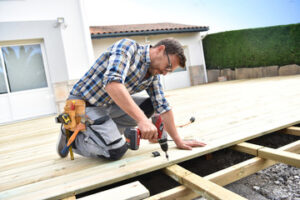During a visual inspection, the inspector looks for leaks and structural concerns. Leaks manifest as water stains or musty odors, and wear and tear shows up as granule loss on asphalt shingles or splits in wood shingle roofs.

They also look for rust or cracked seals on flashing around penetrations like skylights and vent pipes. They also examine fascia boards and soffit materials for rot. Get professional help from Roofing Helena MT today.
Visual inspection is a key component of the broader field of Non-destructive Testing (NDT). The process involves carefully examining physical objects to detect defects, anomalies, and deviations from established quality standards. It plays a vital role in ensuring operational excellence, protecting consumer interests, and fortifying industrial integrity.
The benefits of visual inspection are many, ranging from increased efficiency and cost-effectiveness to the ability to identify a wide variety of defects and issues. Additionally, the inspection process is non-destructive and therefore can be performed on a broad range of materials. However, despite its many advantages, visual inspection is prone to inconsistencies and limitations.
A common challenge is subjectivity, which can skew results and reduce the effectiveness of the inspection process. This is especially true in complex environments where the location of defects may be difficult to discern. Additionally, visual inspections are typically limited to surface-level detection capabilities and cannot detect subsurface flaws or internal damage. Lastly, the accuracy of visual inspections can be affected by environmental conditions such as lighting, glare, or obstructed views.
To overcome these challenges, it is essential to establish a clear definition of defect criteria and standardize inspection performance. This helps to ensure that inspectors are consistently identifying deviations from established norms, and it also allows for comparison of inspection data over time. Additionally, it is important to use proper equipment and training to ensure that visual inspections are conducted safely and efficiently.
Fortunately, technology has paved the way for more efficient and accurate visual inspections. Specialized robots equipped with advanced imaging technologies can perform inspections in challenging, hazardous, or otherwise inaccessible areas. Remote Visual Inspection (RVI) tools, such as drones and robotic cameras, can also provide a detailed view of a location or facility from a safe distance, which is ideal for environments with potential risks to human safety.
When performing visual inspections, it is important to follow the appropriate safety protocols and follow all applicable regulations. This includes using protective gear, adhering to environmental guidelines, and ensuring that access equipment is properly maintained. It is also important to use a systematic approach to inspect all areas of interest and to document all findings accurately and thoroughly. In addition, it is important to communicate findings with relevant parties and propose improvement measures as needed.
Ladder Inspection
Ladder inspection is a vitally important aspect of workplace health and safety. A faulty ladder can cause serious and life-changing injuries, so it’s essential that workers carry out detailed visual inspections before using a ladder. A worker who fails to inspect a ladder correctly could face significant fines or even prosecution. As such, it’s important to ensure that your employees are properly trained in how to conduct a ladder inspection and understand the requirements of ladder-specific standards and regulations.
A thorough inspection should include checking the ladder’s footings to make sure that they are stable and not loose or damaged, verifying that any spreader or locking devices are fully engaged and functional, examining the steps for signs of damage, and checking whether rung locks are present on extension ladders. It is also necessary to check that the ladder is in good condition and free of paint and other substances that could make it slip or become unstable.
The inspection process should be documented, and any issues identified should be reported to a supervisor for action. A good way to document the findings is to create a ladder inspection checklist that can be used by workers to help them identify any potential problems and take corrective actions before the problem becomes worse.
Detailed visual inspections of ladders should be carried out at regular intervals and recorded, and records should be available for review. The intervals can vary according to the manufacturer’s instructions, but a detailed visual inspection should be conducted before each use of a ladder. Ladders that are found to be faulty or damaged should not be used, and should be clearly marked as unfit for work and locked away.
Manual hazards remain one of the biggest causes of injury in the construction industry, and ladders are no exception. But with routine inspections, careful use, and following safety protocols, ladder-related accidents can be prevented. Our Ladder Inspection Training helps trainees develop a deeper understanding of how to effectively undertake ladder inspections, looks at the legal requirements and common faults that can lead to accidents, and covers the practical steps to taking action if a ladder is found to be unsafe.
Ground Inspection
Many homeowners overlook the importance of their roof, assuming that it’s “out of sight and out of mind.” However, your roof is one of the most important components of your home. It protects your family, possessions, and the rest of the structure of your home from moisture and other damaging elements.
If you’re thinking of selling your home or are simply maintaining it, a professional roof inspection can save you money in the long run by catching small problems before they become major issues. A certified inspector will use both a visual and on-the-ground inspection to find problems like leaks, standing water, mold and mildew, sagging, shingle damage, and more.
The inspector will walk across the surface of your roof to look for any areas that are loose, curled, or cracked. He or she will also check the condition of shingles and flashing. Shingles should be straight and flat against the roof, free of stains and moss, and free of missing or damaged granules. The inspector will also examine the underside of your roof, scanning rafters and joists for structural integrity.
Water damage can lead to rot and sagging, so the inspector will also look for any areas that are moist or dark. If the inspector finds any of these issues, he or she will recommend that you hire a contractor to do some roof repair before they get worse.
An inspector will also examine the gutters and soffit for signs of mold, rust, or rotting. The inspector will also look for vent pipes, skylights, chimneys, and other accessories. Finally, the inspector will take a sample of the shingle material for testing.
If the inspector finds that your roof is in good condition, he or she will provide you with a certificate that you can give to prospective buyers when you’re ready to sell your home. This will help you substantiate your claim that the roof is in good condition, which can increase the value of your home and speed up the sale process. In addition, a written certification from a certified inspector can help you qualify for special homeowner’s insurance rates and may be required by your mortgage company.
Attic Inspection
An attic inspection reveals information about your roof and the house as a whole. It also helps you fight high energy bills, mold and poor air quality. A home inspector will check the attic’s ventilation, insulation and structural integrity. The inspector will look for signs of leaks like water stains and wood rot.
An inspector will use a ladder or crawl space to access the attic. They will measure the depth of insulation to ensure it’s adequate. The inspector will also note any spots where more insulation is needed. They may also look for a soffit vent that could be blocked by debris or a clogged chimney flue.
If the attic has an unfinished area, the inspector will look for bare joists and sheathing. In Florida, it’s important that the attic framing is constructed well to support the heavy loads of a roof system. The attic will also reveal if the roof was installed correctly during construction. If a roof is damaged, it can leak and cause problems throughout the home.
The inspector will also note the condition of the attic vents and exhaust ducts, including whether there are any crisscrossing ducts that may interfere with proper ventilation. The attic should be insulated to prevent heat from escaping through the attic, causing the house to overheat.
Rodents, birds and other pests often nest in attics. They leave droppings and messes that must be addressed before they cause damage to the rest of the house. An attic inspection should be done every time you do a visual inspection, and every time there is a significant change in temperature. You can perform an attic inspection on your own, but it’s safer and more thorough to have a professional inspect the attic and the rest of the home.




